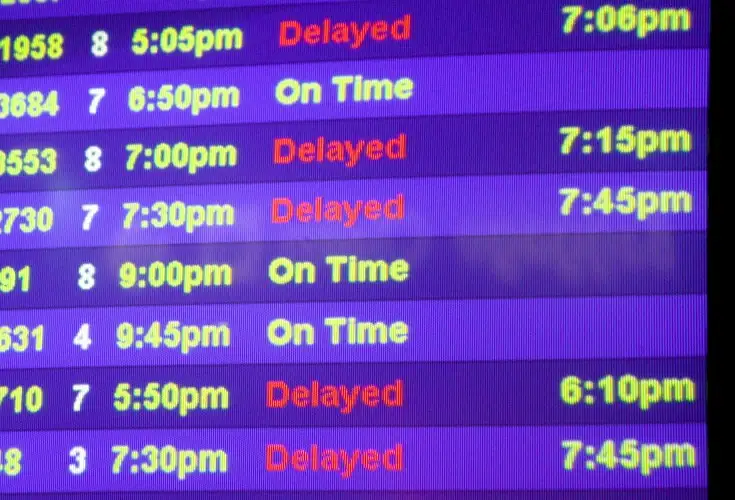
The Department of Transportation’s (DOT) new tarmac delay rules don’t go into effect until April 29, but already signs are pointing to a sharp rise in flight cancellations as a result of the policy. Alan Levin at USA Today reports that the “nation’s recent onslaught of flight cancellations is a harbinger of what passengers can expect from airlines looking to avoid new multimillion-dollar fines for leaving people stranded on grounded planes in bad weather”
It’s a simple matter of math, Levin writes. “Cancellations cost far less than a huge fine, especially since seats are routinely prepaid and airlines save fuel cost.”
Levin points out that cancellations spiked at JetBlue when the low-cost carrier implemented a self-imposed four-hour limit for tarmac delays. “In 2005 and 2006, the carrier canceled an average of 254 flights a year, according to federal Bureau of Transportation Statistics data. After the Valentine’s Day strandings [in 2007], when the airline set a rule that no flight could be delayed on the ground more than four hours, the figure jumped to 1,223 a year.”
Levin also suggests that some airlines may aggressively drop flights from their schedules during bad weather. If this were to happen, storms and other events would lead to more flights being cancelled than before. Levin reports that 15,000 flights have been cancelled in the past 10 days due to storms, forcing upwards of a million passengers to rebook.
People point their fingers at the DOT for imposing these restrictions with seemingly little concern for the consequences, and there’s some truth to this. The DOT really doesn’t seem to care much about the practicality (or lack thereof) of its three-hour policy.
But it’s been noted before that these rules seem targeted more at forcing reform on the industry than just at saving stranded passengers. After all, long tarmac delays are hardly a widespread problem. Just this past December, a mere 0.007 percent of flights had tarmac delays of three hours or more. Only one flight sat on the tarmac for four hours or more.
Instead, the DOT is forcing the industry to address issues it has by and large ignored. Tarmac delays are a symptom, not a disease, and the DOT is hoping its rules force the industry to address the underlying inefficiencies that lead those rare but headline-grabbing debacles. After all, the three-hour rule got most of the attention, but the DOT’s policy included new requirements in numerous other areas as well.
But what about the passengers. We’re the odd ones out here, as the DOT and airline industry hash out their differences. What’s in it for us? Are we supposed to be happy that instead of sitting on the tarmac for half a day, we get to spend that half-a-day on hold trying to rebook our cancelled flight?
Personally, I’m not happy about either, but I am cautiously optimistic. The DOT has established itself as a friend of the consumer, with aggressive action against misleading practices and promises to address issues like bag fees and full-fare advertising. I think the three-hour rule is perhaps a bit misguided but is also focused on long-term goals that should benefit the traveler, such as realistic scheduling and better monitoring of delays. Hopefully those goals are realized.
But enough from me, what do you think?
We hand-pick everything we recommend and select items through testing and reviews. Some products are sent to us free of charge with no incentive to offer a favorable review. We offer our unbiased opinions and do not accept compensation to review products. All items are in stock and prices are accurate at the time of publication. If you buy something through our links, we may earn a commission.
Related
Top Fares From
Today's Top Travel Deals
Brought to you by ShermansTravel
Shop and Save with Country Inns...
Patricia Magaña
 Hotel & Lodging Deals
Hotel & Lodging Deals
$229 -- Chicago: Discounted Rates and...
Francesca Miele
 Hotel & Lodging Deals
$229+
Hotel & Lodging Deals
$229+
$188 -- Honolulu: Save on Oceanview...
Abigail Lamay
 Hotel & Lodging Deals
$188+
Hotel & Lodging Deals
$188+



